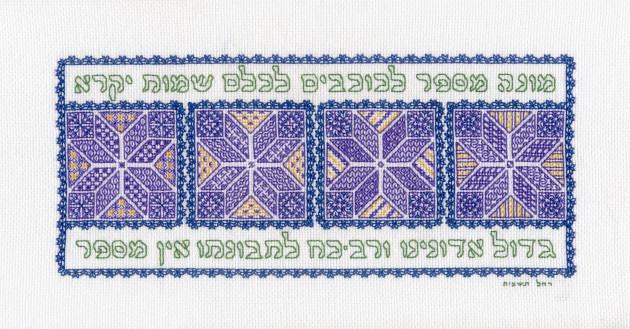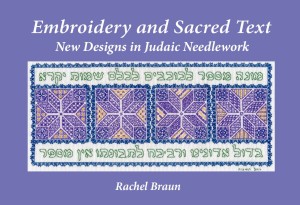Author Archives: Rachel Braun
July 10, 2017 by Rachel Braun
Embroidering a Jewish Life

God Counts the Stars, 2015, Rachel Braun. Scan by Philip Bookman.
Embroidery has been part of my life for over two decades; it is a core Jewish practice for me and an entry point into sacred texts. I design Judaic embroidery, starting with words from Torah or liturgy, then elucidating and interpreting the words with needle and thread. But before I discovered my embroidery passion, I’d thought about needlecraft only in limited ways.
In college, some 40 years ago, I read an article about Colonial quilt-making for an anthropology class. The author wondered why Colonial women would commit to such a painstakingly slow production process. Indeed, needlecraft is very laborious! Designing and stitching an embroidery canvas can take me easily 150 hours.
The author’s hypothesis was that usually women were responsible for repetitive production processes which had temporary outcomes, living under a tyranny of iterative tasks. Women cooked and fed their families; hunger returned anew. We laundered clothing; those garments became soiled. We cleaned; dirt arose again in every corner. Quilting, the author concluded, allowed women to participate in permanent material culture, establishing and recording their presence. Perhaps not as physical as barn-raising (and not as well paid?), but still valued.
In my adult life, I’ve become aware of the impermanence of traditional female tasks, though my responses to the feeding-laundering-cleaning conundrums of Colonial women may have differed. Raising four children, I cycled through three basic lentil recipes at dinner and taught my kids to use the washing machine. As for cleaning, my mantra became “as long as the kids don’t get cholera, the house is clean enough.” They didn’t, and it was.
 But I do embroider—vigorously, creatively, spiritually. Am I, as was alleged for our Colonial quilters, seeking immortality in material culture? That premise seems a bit specious: what we call women’s work (and what that treatise I read in college alleged was impermanent) is indeed permanent work: a long-term investment in the continuity and culture of humanity, as stabilizing as building a barn. But material culture has its purpose—useful, beautiful, necessary, communal. My framed embroidery pieces adorn the walls of my home and shul, and I dream that one day they will be passed to future descendants, or even considered museum-worthy. Just in case they aren’t, I’ve made a dive at immortality by sharing them in a book, Embroidery and Sacred Text (2017).
But I do embroider—vigorously, creatively, spiritually. Am I, as was alleged for our Colonial quilters, seeking immortality in material culture? That premise seems a bit specious: what we call women’s work (and what that treatise I read in college alleged was impermanent) is indeed permanent work: a long-term investment in the continuity and culture of humanity, as stabilizing as building a barn. But material culture has its purpose—useful, beautiful, necessary, communal. My framed embroidery pieces adorn the walls of my home and shul, and I dream that one day they will be passed to future descendants, or even considered museum-worthy. Just in case they aren’t, I’ve made a dive at immortality by sharing them in a book, Embroidery and Sacred Text (2017).
- 6 Comments
 Please wait...
Please wait...